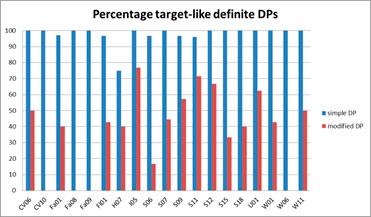Yvonne van Baal
Compositional Definiteness in Heritage Norwegian
Yvonne van Baal, University of Oslo (Friday 10:30-11:00)
In this paper I show that speakers of Heritage Norwegian have non-target-like definiteness marking in modified definite NPs. This provides insights in both heritage languages and in the construction of Norwegian modified definite phrases.
Background
The study of Heritage Norwegian (HN) is important for two reasons. First, the current speakers of HN are the last generation, which means both that the language is dying and that the speakers do not have many people around them to speak Norwegian with. Second, HN is an a-typical heritage language: while much research focuses on second generation immigrants (Montrul 2012), the current speakers of HN are third or fourth generation immigrants (Johannessen & Salmons 2012, 2015).
This paper studies the linguistic competence and performance of speakers of HN with regard to Compositional Definiteness (CD). CD is found in Norwegian NPs, where definiteness is expressed with a suffix on the noun (1a), but with both a suffix and a prenominal determiner when the noun is modified (1b-c).
(1)
a. hest-en ‘horse-DEF.SG’ “the horse”
b. den hvit-e hest-en ‘DEF.SG white-DEF horse-DEF.SG’ “the white horse”
c. *hvit-e hest-en ‘white-DEF horse-DEF.SG’
Since monolingual Norwegian children need a relatively long time to acquire CD (Anderssen 2007), and modified definite structures are not very frequent (Dahl 2015:121), the question rises how heritage speakers behave with respect to CD. Previous research on the spontaneous speech of HN speakers (collected in the Corpus of American Norwegian Speech (CANS), Johannessen 2015a) has shown that many of them use patterns that are ungrammatical in homeland Norwegian (Anderssen & Westergaard in press), and at least one of the speakers in the corpus has been argued to be attrited (Johannessen 2015b).
Experiment
To complement the studies on spontaneous speech, this paper presents results from an experimental study. In a translation task, speakers of HN were asked to translate sentences from English to Norwegian. These sentences contained both simple and modified noun phrases in both indefinite and definite contexts, as in the following examples
(2)
a. “flowers”
target: blomst-er
‘flower-INDEF.PL’
simple indefinite
b. “the kitchen”
target: kjøkken-et
‘kitchen-def.sg.n’
simple definite
c. “a little girl”
target: ei lita jente
‘indef.sg.f little.f girl’
modified indefinite
d. “the red apples”
target: de rød-e epl-ene
‘def.pl red-def apple-def.pl’
modified definite
The translation task was conducted during fieldwork in the US (fall 2016). Nineteen speakers participated in the experiment. Spontaneous speech of six of these speakers is included in the CANS.
Results
The responses of the participants are analysed as target-like or non-target-like (i.e. grammatical or ungrammatical in homeland Norwegian). Results are shown in figure 1. It is clear that while 18 out of 19 speakers perform at ceiling with respect to definiteness marking in simple definite phrases (≥95% of their utterances target-like), none of them performs at ceiling with respect to CD in modified definite phrases.
There is however large variation between speakers, both in amount and type of deviations. Four speakers never produce CD when it is obligatory, seven speakers perform target-like in 50% or more of their utterances (highest percentage of target-like utterances: 77%) and seven speakers in less than 50% of their utterances.
Different types of deviations are found. Almost all participants (18 out of 19) leave out the prenominal determiner in some or all of their utterances. This is by far the most common non-target-like structure. Only a few participants (6 out of 19) leave out the suffixed article in some cases, but 5 of them also leave out the determiner in other cases.
Conclusion
These results clearly show that the production of CD of heritage speakers deviates in systematic ways from that of homeland speakers. It is also clear that for these speakers, the prenominal determiner is most often left out. The paper discusses possible explanations for these deviations.

Figure 1. Percentage target-like definite DPs in simple (blue) and modified (red) contexts.
References
- Anderssen, M. (2007) The Acquisition of Compositional Definiteness in Norwegian. Nordlyd 34.
- Dahl, Ö. (2015) Grammaticalization in the North. Language Science Press.
- Anderssen, M. & M. Westergaard (in press). Crosslinguistic similarities and differences in bilingual acquisition and attrition: Possessives and double definiteness in Norwegian heritage language. Bilingualism Language and Cognition.
- Johannessen, J.B. (2015a) The Corpus of American Norwegian Speech (CANS). In: Béata Megyesi (ed.): Proceedings of the 20th Nordic Conference of Computational Linguistics.
- Johannessen, J.B. (2015b) Attrition in an American Norwegian heritage language speaker. In: J.B. Johannessen & J. Salmons: Germanic heritage languages in North America: Acquisition, attrition and change.
- Johannessen, J.B. & J. Salmons (2012) Innledning. Norsk lingvistisk tidsskrift 30.
- Johannessen, J.B. & J. Salmons (2015) The study of Germanic Heritage Languages in the Americas. In J.B. Johannessen & J. Salmons: Germanic Heritage Languages in North America: Acquisition, Attrition and Change.
- Montrul, S.A. (2012) Is the heritage language like a second language? EuroSLA Yearbook 12.
